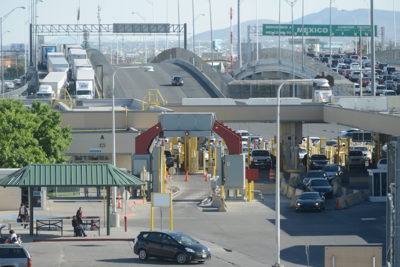Getting accurate, continuous travel information can be difficult for binational metropolitan regions like El Paso and Ciudad Juárez. As a result, international cross-border trips often go underrepresented in travel demand and behavior analysis studies. This can be caused by a number of factors, including time and budget limits and boundary issues associated with international jurisdictions. Transportation agencies are interested in technologies such as smartphones as an additional data source for gleaning travel information.

Exploration of Cross-Border Trip Characteristics Using Crowdsourced Data, published by the Texas A&M Transportation Institute’s Center for International Intelligent Transportation Research (CIITR), looks at the value crowdsourced data can add to the travel information equation. The report’s authors are Rafael Aldrete, CIITR director and senior research scientist; Okan Gurbuz, assistant research scientist; David Salgado, assistant research scientist; Ipek N. Sener, principal investigator of the study and research scientist; and Erik Vargas, graduate student worker.
“We’re living in exciting times of technological and data analytics advancements,” notes Dr. Sener. “These emerging data sources can be especially helpful for understanding and regulating cross-border travel, given today’s limited resources and lack of reliable data to address the unique needs of regions where different languages, cultures and economies intersect. Our research explores the potential of using crowdsourced data to better understand cross-border trips and travel patterns, as well as assist officials in developing robust, data-driven policies that benefit every transportation system user.”
Specifically, the research team evaluated how crowdsourced data can be used for acquiring cross-border trip characteristics. The team focused on the period January–April 2020 to better identify patterns at the beginning of the COVID-19 pandemic and take into account border restrictions at the U.S.–Mexico border. Data came from five land ports of entry (POEs) in the El Paso–Juárez region across the Bridge of the Americas, Paso del Norte, Stanton, Santa Teresa and Ysleta–Zaragoza.
The team found the Ysleta–Zaragoza POE had the highest cross-border trip volume while Santa Teresa had the lowest during the study period. The most common purpose for a northbound trip was shopping; for a southbound trip, it was a hospital visit. Not unexpectedly, data showed that trips to El Paso dropped significantly after the pandemic announcement in March 2020, when border travel restrictions were put in place. As part of their assessment, researchers also noted limitations related to either the data themselves or the way they were acquired, as well as the importance of taking proper steps to “clean” the data and prepare them for analysis. Despite such considerations, crowdsourced data offered useful insights for cross-border travel and provided unique, new opportunities especially when combined with other data sources, to assist with transportation planning.
“Numerous crowdsourced data vendors are emerging every year,” Dr. Aldrete says. “Researchers and transportation agencies need to understand the opportunities and limitations of data offered by these vendors before investing significant resources in purchasing them or, more importantly, relying on them. In the long run, however, a more accurate and complete understanding of cross-border trips — from point of origin to destination and all points in between — can prove highly beneficial for transportation planners who daily face the need to do more with less resources.”